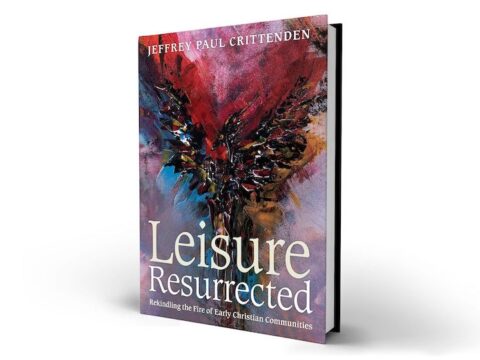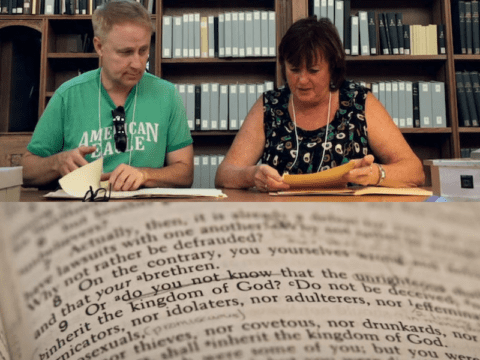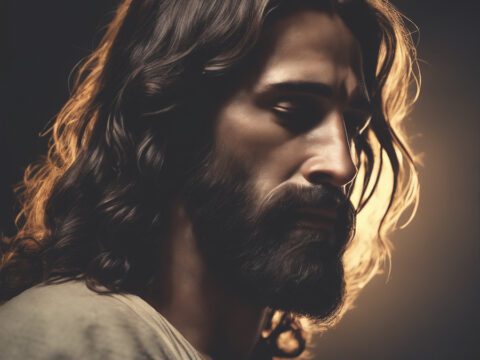Somewhere in my mother’s basement is a drawing I did in my Catholic-school kindergarten class. It’s meant to be a Nativity scene, but Jesus is an afterthought, he and his crèche relegated off to one side along with Joseph. In my version, Mary is the star of the show, and the caption, written by my teacher, reflects this: “C’est la maman de Jésus. Voici son papa. Et le bébé Jésus.” (“It’s the mother of Jesus. Here is his father. And the baby Jesus.”)
Sure, Jesus was the Son of God, the Saviour, the Messiah, but he didn’t capture my interest the way his mother did.
As a little girl, I loved all the Catholic imagery of Mary, from the depictions of her as the Queen of Heaven, complete with sumptuous robes and a crown, to those that portray her in the much humbler circumstances surrounding her son’s birth. Sometimes I would drape a blue towel over my head and pretend to be her, and in those moments, I imagined I felt something close to her holiness.
Just a few years later, though, I came to resent Mary. I had a very hazy understanding of the doctrine of the Immaculate Conception, the Catholic dogma that explains Mary’s freedom from original sin. But I knew that to be free from sin one had to be well-behaved. I was always in trouble for talking too much or rushing through my work or coming in late from recess. Every morning, I would tell myself that I was going to get through the day without tripping up. Every night, I would tally up my failures and despair.
I knew Mary’s type, or thought I did — the girls who were pious, who sat quietly, who were beloved by teachers and parents alike. Mary might have been Good with a capital G, but I was pretty sure she’d be insufferable to know.
With my teen years and a dawning feminist consciousness, my disdain increased. Unlike so many women in scripture, the Virgin Mary didn’t really do anything beyond agreeing to be a passive receptacle for God, and even then, did she have much choice? How do you say no to God? All those pictures of Mary that I’d once loved, those images of pure and selfless motherhood, now seemed insipid to me. I vastly preferred biblical women like Miriam, Deborah, Priscilla or Phoebe — movers and shakers, all of them — to the ever-serene Virgin Mary.
But is it possible that this version of Mary — the meek, docile paragon of motherhood — downplays her actual role? As with the stories of many women, how Mary’s is told is often a reflection of cultural anxieties. In Christian traditions that subscribe to dogma like the Immaculate Conception and Mary’s perpetual virginity, church leaders have used the ideal of her supernatural purity to control women’s bodies, particularly when it comes to their sexuality.
In certain Protestant denominations, Mary has become what Amy-Jill Levine, professor of New Testament and Jewish studies at Hartford International University for Religion and Peace in Connecticut, refers to as “collateral damage during the Reformation.” She means that, in an attempt to distance themselves from the Catholic Church, some Protestants downplay Mary’s role to being little more than a birth-giver. Both Catholic and Protestant approaches dehumanize Mary in their own way, treating her as a symbol rather than a person.
More on Broadview:
- Diana Butler Bass’s viral sermon changed the way thousands think about Mary Magdalene
- Award-winning documentary reveals how a biblical mistranslation fostered Christian homophobia
- Why Jesus is history’s most overlooked conservationist
Some experts, though, see evidence in the Gospels of a much more powerful biblical figure in the Virgin Mary, one who was a prophet in her own right, who held subversive, anti-imperialist views and whose role in shaping Jesus’ ministry was more powerful than is typically believed. Could a closer look at the Gospels show us a different Mary than the one who has been venerated for the past 2,000 years?
Scripture doesn’t actually tell us much about Mary. The Gospel of Mark, the oldest of the four canonical Gospels, has no birth story, and Mary is mentioned a handful of times and only once by name. Neither of Mark’s stories involving Jesus’ mother reflect positively on her. Both seem to be about Jesus rejecting his family of origin and embracing his true kindred: his family of followers.
The Gospel of Matthew does have a birth story, but it centres mostly on Joseph and his prophetic dreams; though Mary is mentioned by name, she doesn’t have any lines.
It’s in the third Gospel, the Gospel of Luke, that Mary really shines. Here, the first two chapters are told almost entirely from her perspective, beginning with the archangel Gabriel’s announcement that she will conceive and give birth to the Son of God, up to her witnessing 12-year-old Jesus’ star turn in the temple courts. After that episode, she appears just once more in another version of the true kindred story, though this one is somewhat kinder to Mary than the telling in Mark.
The Gospel of John, believed to be written last, contains two stories involving Mary, each significant in its own way. First, she appears at the famous wedding at Cana, where she tells Jesus to fix the wine situation. (Jesus replies, “Woman, why do you involve me? My hour has not yet come,” but then obligingly works a miracle.) She then disappears until the crucifixion, when Jesus entrusts her to the care of the unnamed beloved disciple, thus uniting his family of origin with his chosen family.
Want more on Mary? Listen to the episode of our podcast, “And Also Some Women,” that dives into her fascinating story.
After the Gospels, Mary appears just a few more times: in the Acts of the Apostles, Mary is present at the ascension of Jesus, and then she’s mentioned again in Paul’s Epistle to the Galatians. The latter is chronologically the oldest reference to Mary — scholars estimate this letter is about 15 years older than the Gospel of Mark. In it, Paul writes, “But when the set time had fully come, God sent his Son, born of a woman, born under the law, to redeem those under the law, that we might receive adoption to sonship.” Although it’s not explicitly stated there, a reader might see the implication of a virgin birth, since otherwise Paul might have written something like “born of a man and a woman.”
Some Christian traditions also associate Mary with the woman clothed with the sun from Revelations, known as the Woman of the Apocalypse, since that unnamed character gives birth to a son who “will rule all the nations with an iron sceptre.”
Altogether, Mary’s scriptural appearances aren’t much to go on, which is probably why so many non-canonical sources — particularly such apocryphal gospels as the Protevangelium of James from the second century and the Gospel of Pseudo-Matthew, which dates from the early medieval period — try to fill in the gaps in Mary’s story.
“Both stories give more full representations of her childhood and more details about how and why she was a virgin, a model of purity and wife to Joseph,” says Brandon Hawk, an associate professor at Rhode Island College who specializes in Christian apocrypha. Hawk also says that these gospels, both of which give Mary miraculous origins, helped early Christians work through the tension presented by the fact that Jesus was both fully divine and fully human. That idea might seem unremarkable to most modern Christians, but it was a source of intense conflict in the early church.
According to Hawk, many Christians continue to be influenced by these gospels, even if they’ve never heard of them or read any apocrypha for themselves. For example, the Protevangelium is the first source for the names of Mary’s parents, Joachim and Anne. It’s also the earliest suggestion that Mary was a virgin not just before Jesus’ birth, but afterwards, too — a notion that set the stage for the doctrine of perpetual virginity, which is observed by the Catholic and Eastern Orthodox churches, as well as some Protestant denominations. Meanwhile, Pseudo-Matthew has a passage about the flight into Egypt that has been important to the Coptic Orthodox Church.
Official church interest in these gospels doesn’t just belong to the past, either. In a June 2006 sermon, Pope Benedict XVI cited the Protevangelium as a text that “exalts the holiness and virginity of Mary, Mother of Jesus.”
***
Feminist biblical scholars have cast new eyes on Mary, and see much more in her than a virgin and holy mother. Amy-Jill Levine specializes in Second Temple Judaism, a period in Jewish history that stretches from 516 BCE to 70 CE, and her understanding of Mary is informed by her knowledge of what women’s lives would have been like in first-century Judea and Galilee.
“We know that in the household — and this is still the case to this day — women are the primary teachers of little children, not only how to function in the household, but also their initial religious trainers,” says Levine. Given that this was such a common dynamic, she believes it’s likely that Jesus’ earliest understanding of scripture would have come through his mother’s instruction.
Levine also suggests that some of Jesus’ anti-Roman sentiments might have come from Mary. Judea had been an independent kingdom from the middle of the second century BCE up to 63 BCE, when Rome invaded and divided the country. Someone growing up in that time and place — as Mary is said to have done — would have been keenly aware of Roman atrocities like the razing of the city of Sepphoris in 4 BCE. In fact, some Christian traditions even hold that Sepphoris, which is close to Nazareth, was Mary’s birthplace. Levine also points to books in the Old Testament apocrypha that depict Jewish men and women being killed for practising their faith.
“It would not surprise me that some of Jesus’ own teachings about what the kingdom of God looks like, as opposed to the kingdom ruled by the Roman Empire … came directly from his mother,” says Levine.
Further evidence of Mary’s antiempire ideas can be found in the Magnificat, the hymn she sings at her cousin Elizabeth’s house in the Gospel of Luke (see “The Magnificat,” page 25). Levine refers to the song as Mary’s “manifesto of social justice,” and in it Mary tells of how God will bring about equality by casting down the mighty, raising up the lowly and feeding the hungry.
Barbara Reid, a Dominican sister and president of the Catholic Theological Union in Chicago, sees parallels between the Magnificat and the song Miriam sings in Exodus, a song that celebrates God rescuing the Israelites from slavery in Egypt. It’s an especially potent comparison, because Mary was likely named after Miriam, who helped lead the way to freedom. Reid also notes that many of the titles that Mary uses for God — such as “Lord Saviour” and “Mighty One” — are titles that Roman emperors, including Caesar Augustus, enjoyed using for themselves. It’s almost as though Mary is using the emperor’s own language to tell him there’s a power even greater than him.
“She also sings about filling up the hungry,” says Reid, “and that doesn’t sound terribly subversive, but keeping poor people poor, and hungry people hungry is a tactic of an oppressive and colonizing power, and keeping people always food insecure … is a tactic of oppression.”
One of the most interesting uses of language that Reid sees in the Magnificat is the word that Mary uses to describe herself, tapeinosis, a term in Koine Greek (the dialect in which the New Testament was written and an antecedent to Modern Greek). Tapeinosis is often translated as “humility” or “lowliness,” but Reid says it should really be translated as “humiliated.” Mary uses the same word a few verses later when she says God will lift up the humiliated.
The verb tapeinoō also appears in the Septuagint, which is the Greek translation of Hebrew scriptures and is what the Gospel writers would have been most familiar with. There, it’s used several times to describe the sexual humiliation of women who had been raped — and, of course, rape was and is a common weapon used in war. So along with Mary singing about God bringing about peacefulness, she might also be calling out sexual assault by Roman soldiers, and promising that God will end that, too.
“This is a powerful hymn,” says Reid, “that both exalts God’s saving deeds in the past, but also counts on God to continue to save, to liberate, in the future…not just in individual acts of mercy and kindness, but [in] ways that get at the root causes of injustice and overturn those.”
Reid also sees evidence in scripture of Mary being a prophet in her own right. For one thing, she notes that the calls of prophets often follow a similar pattern. They begin with an encounter with a divine messenger, usually amid everyday life, followed by the resistance of the person being called. Then the messenger will often offer reassurance and maybe even a tangible sign from God. Mary’s encounter with Gabriel follows this pattern exactly: the archangel appears and tells her she will bear God’s son; Mary asks how this could be possible since she’s a virgin; Gabriel explains that it will happen through the Holy Spirit; he offers Mary a sign in the form of her cousin Elizabeth’s pregnancy.
“What I see in the [Annunciation] scene with Mary is rather different, I think, than what many people have seen, where they emphasize Mary as docile, as humble, as self-effacing, as ‘whatever you want, I’ll do whatever you say.’ Almost a puppet of God, and God never calls puppets,” says Reid. “God always wants a person who, out of an autonomous, strong sense of self, makes a free choice to make God and God’s work the centre of their life and not their own desires. And Mary exemplifies that.”
Then there’s the fact that the Magnificat is a prophetic message — through it, Mary becomes a vessel of divine communication, foretelling what God will do through her unborn son. In fact, Reid sees Mary as a “model theologian” throughout the first two chapters of the Gospel of Luke. Luke tells us that she wonders, that she ponders, that she treasures the information she gathers in her heart. Through the Magnificat, she shows an understanding of how unjust systems keep people poor and hungry. She’s not meek but strong, able not just to endure private and public scrutiny of her strange pregnancy but to praise God throughout.
Finally, Reid sees significance in the fact that, in the Gospel of John, Mary is the one who knows when it’s time for Jesus to begin his public ministry. And though Jesus tries to argue with her, in the end she’s right — John tells us that it’s after the wedding at Cana that people really begin to believe in him. And while the fourth Gospel doesn’t include an infancy narrative, Reid sees the motif of birth throughout — first with the birthing of Jesus’ ministry at Cana and then the birthing of the new Christian community at his death. At both, Mary plays the role of a midwife, easing the passage between the old and the new.
***
In 431 CE, the Council of Ephesus, a council of bishops representing all of Christendom, officially declared Mary to be the Theotokos, which means “God-bearer” in Greek. This title, in use since the third century in some Eastern traditions, was meant to resolve the tension inherent in Christianity: that of understanding Jesus as both fully human and fully divine. Of all Mary’s titles, I think I like this one the best. It doesn’t define her through her purity, like “Virgin Mary” does, and it doesn’t define her solely through her relationship with her son, like “Mary, the Mother of Jesus” does. Rather, it recognizes the incomprehensibly sacred act that she is described as performing, that of carrying God within her, nurturing him with her body, spending nine months knowing Jesus in a way that no one else ever could before delivering him to the world.
If Jesus is divine, it’s his human moments that I love the most: the times when he’s angry, when he’s frustrated, when he despairs in the Garden of Gethsemane knowing everything that’s about to come. Of course, we know that as the Son of God, he’ll be resurrected after his death. But it’s because he’s the son of Mary that we get to see these relatable flashes of humanity.
I came back to Mary when I was pregnant with my son. I hadn’t been to mass for years, and it would be another decade or so before I went to mass again. But I began frequenting a shrine to Our Mother of Perpetual Help, which happened to be just down the street from the hospital where I would deliver my son. Before every prenatal appointment, I would light a candle and pray: “Please, Mary, let everything be okay.” I didn’t really know if I believed in anything, but I found the ritual comforting during that anxious, uncertain time.
In the years since, I’ve often thought of Mary, not as that smug, pious girl I once pictured, but as someone in the trenches of motherhood, trying to raise a child she adores but cannot fully understand. I’d imagine that parenting the Saviour is not a task for the faint of heart. I agree with Sister Barbara Reid that God knew exactly who God was choosing for this role: someone strong, someone resourceful, someone who could help prepare God’s son for the enormous task he would soon face.
***
Anne Thériault is a journalist in Kingston, Ont.
This story first appeared in Broadview’s December 2023 issue with the title “A Different Mary.”
















Jesus did not have an anti – Roman sentiments. He had anti Pharisee sentiments. Jesus never once criticised Rome and and Rome was completely indifferent to him. Rome was not indifferent to the complaints of the Sanheidren who forced the Romans to crucify Jesus.